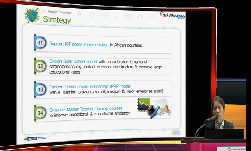Identification of cognitive variables that affect how welfare recipients process employment information, make occupational decisions, and solve work problems is important to the design of appropriate job training interventions for this population. Th...
http://chineseinput.net/에서 pinyin(병음)방식으로 중국어를 변환할 수 있습니다.
변환된 중국어를 복사하여 사용하시면 됩니다.
- 中文 을 입력하시려면 zhongwen을 입력하시고 space를누르시면됩니다.
- 北京 을 입력하시려면 beijing을 입력하시고 space를 누르시면 됩니다.
Social indicators, dysfunctional cognitions, and career decision-making self-efficacy in work role participation of TANF recipients.
한글로보기https://www.riss.kr/link?id=T10561212
- 저자
-
발행사항
[S.l.]: University of Georgia 2001
-
학위수여대학
University of Georgia
-
수여연도
2001
-
작성언어
영어
- 주제어
-
학위
Ph.D.
-
페이지수
267 p.
-
지도교수/심사위원
Director: Jay W. Rojewski.
-
0
상세조회 -
0
다운로드
부가정보
다국어 초록 (Multilingual Abstract)
The sample of TANF individuals did not conform to the stereotypical image of welfare recipients in that they were older, better educated, and more heterogeneous than is typically thought. A majority of participants indicated at least some problem with dysfunctional career thoughts with external conflict being the highest level of difficulty. Levels of career decision-making self-efficacy were lower than levels of career self-efficacy in a normative sample of college females with the lowest levels of confidence in career planning and problem-solving tasks. <italic>T</italic>-tests revealed that Black recipients spent more significant time in work activities than White recipients, and non-high school completers indicated more significant decision-making confusion and commitment anxiety but less career decision-making self-efficacy than high school completers. Multiple regression analysis revealed that 11.8 percent of the variance in work role participation could be explained by the social indicators and cognitive variables combined. Supplementary analyses revealed that career decision-making self-efficacy was the single most important predictor of the variables studied.
Results contribute to research literature describing cognitive variables and vocational behavior of socio-economically disadvantaged individuals. Findings may also assist job training practitioners in interventions designed to effect more satisfactory employment outcomes.
Identification of cognitive variables that affect how welfare recipients process employment information, make occupational decisions, and solve work problems is important to the design of appropriate job training interventions for this population. This study developed a profile of individuals who receive Temporary Aid to Needy Families (TANF). It also examined the contribution of selected social indicators and four cognitive constructs to variation in work role participation. Three instruments were administered—the demographic profile and Participation scale of the <italic>Salience Inventory</italic> (Super & Nevill, 1985), the <italic>Career Thoughts Inventory</italic> (Sampson, Peterson, Lenz, Reardon, & Saunders, 1996a), and the <italic> Career Decision-Making Self-Efficacy Scale-Short Form</italic> (Betz, Klein, & Taylor, 1996)—to determine how well race, education level, dysfunctional career thoughts (decision-making confusion, commitment anxiety, external conflict), and career decision-making self-efficacy predicted work role participation in a sample of 104 individuals receiving TANF assistance.
The sample of TANF individuals did not conform to the stereotypical image of welfare recipients in that they were older, better educated, and more heterogeneous than is typically thought. A majority of participants indicated at least some problem with dysfunctional career thoughts with external conflict being the highest level of difficulty. Levels of career decision-making self-efficacy were lower than levels of career self-efficacy in a normative sample of college females with the lowest levels of confidence in career planning and problem-solving tasks. <italic>T</italic>-tests revealed that Black recipients spent more significant time in work activities than White recipients, and non-high school completers indicated more significant decision-making confusion and commitment anxiety but less career decision-making self-efficacy than high school completers. Multiple regression analysis revealed that 11.8 percent of the variance in work role participation could be explained by the social indicators and cognitive variables combined. Supplementary analyses revealed that career decision-making self-efficacy was the single most important predictor of the variables studied.
Results contribute to research literature describing cognitive variables and vocational behavior of socio-economically disadvantaged individuals. Findings may also assist job training practitioners in interventions designed to effect more satisfactory employment outcomes.
분석정보
연관 공개강의(KOCW)
-

Education Policy at the Party Conferences
Teachers TV Teachers TV -

Alcohol Education: Here's What We Want
Teachers TV Teachers TV -

Further Education: Work Experience
Teachers TV Teachers TV -

Early Sex Education: The Debate
Teachers TV Teachers TV -

2014 이러닝 국제 콘퍼런스 : What is the Lessons from Education Support Project~
한국교육정보진흥협회 Boseon, Kim






